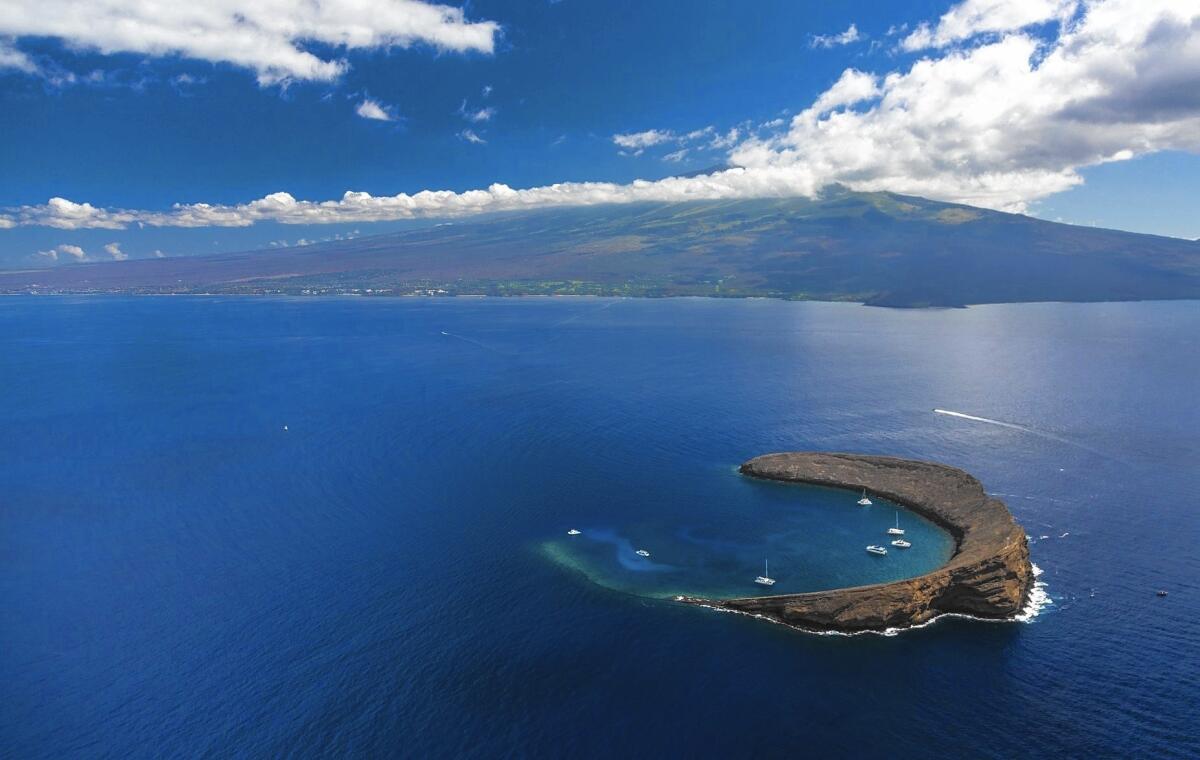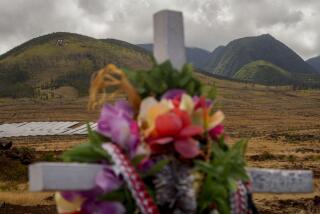Reward for braving swells: Glorious snorkeling at Molokini off Maui

- Share via
Reporting from KIHEI, Hawaii — “When anxious, uneasy and bad thoughts come, I go to the sea,” Rainer Maria Rilke wrote.
This is where the 19th century Austrian poet and I part ways. Not that I don’t appreciate drifting in warm azure waters like those off Maui — if things are calm. But when the sea gets agitated, so do I.
I was relieved that the ocean resembled glass the morning of my snorkeling excursion on the island’s west coast. It was a little before 7 a.m., and I was coating myself with sunscreen and scanning the horizon for whitecaps — none visible, thankfully.
At the Kihei boat ramp, six of us awaited Capt. Joe Neubauer and his 30-foot RAIV (rigid aluminum inflatable vessel) to shuttle us to primo snorkeling locales accessible only by boat. Personally, I would have been content doing my underwater exploring within view of my beach towel.
When the guy in the dive shop assured me that the boat would be “hugging” the shore where “it won’t be rough because it’s morning,” I took his word for it.
But I should have been tipped off by the name of the outfit: Blue Water Rafting.
And had I come across TripAdvisor’s entry titled “Not for the squeamish,” I would not have signed up. The review gave the trip five circles — the highest rating.
“If no one in your party has a tendency to get seasick or motion [sick], this may very well be the best Maui event you can spend money on!” the review proclaimed.
After a short briefing, we were soon cruising along, heading south to La Perouse Bay.
“We’ll come back here later,” Neubauer said. “First, I’m going to take you to my favorite spots.”
Apparently, he was a geology buff determined to enlighten us about the rocks and lava of the Kanaio Sea Caves, formed 600 years ago when Mt. Haleakala exploded and magma surged into the ocean.
I marveled as 61-year-old Neubauer, a former auto parts dealer from Revere, Mass., skillfully navigated around a series of volcanic arches, grottoes and cliffs. Indeed, I was so captivated by the formations that I barely noticed that the once-calm sea was starting to mount.
As we rounded Cape Hanamanioa, Maui’s southernmost point, we were soon heaving on 10-foot swells. Or as Neubauer put it, “This is where the sea gets a little livelier.”
I had my hands in an iron grip on the handrail to prove it. Still, I pretended to be engaging in small talk with a family from San Diego who were unfazed by the turbulent ride.
Fact is I’d sooner bike to the top of a volcano (see “The Challenge of a Lifetime”) than get thrashed about like ice cubes in a high-speed blender. But at least we were heading in the right direction — back to La Perouse, which was named for the French explorer Capt. Jean-François de Galaup, comte de La Pérouse. (A mouthful but not nearly as mellifluous as the bay’s Hawaiian name, Keoneoio.)
With no sea turtles or dolphins in sight, La Perouse was unremarkable, and I lamented not being within easy reach of that beach towel.
Then back on the boat, Neubauer uttered the words I really didn’t want to hear. “I think we’ll try the back wall of Molokini; it seems to be calm that way,” he said. Everyone OK with that?”
As if I’d actually say, “No, we’d rather head back.”
So I stayed quiet.
The crescent-shaped island, formed 230,000 years ago, is a partly submerged volcanic crater about 2 1/2 miles off Maui. During World War II, the U.S. military used the atoll as target practice. But since 1977 it has been protected as a Marine Life Conservation District. For good reason. It has about 250 marine species as well as nesting seabirds. The turbulent water feeds the coral, thus attracting the stunning diversity of sea life.
Above all, it’s a uniquely spectacular diving and snorkeling location with visibility sometimes exceeding 150 feet.
Most tours take you to the calmer, more protected front wall. But Neubauer must have had a sixth sense; as we approached the caldera, the ocean magically flattened and soon we were anchored in a spot usually off-limits — the crescent’s elusive back wall.
As I gazed into the cobalt waters I could tell immediately that this was no ordinary snorkeling spot. After plunging into what best can be described as a Windex-colored fishbowl, I drifted through a dreamland flush with schools of yellow tang and black triggerfish set against a kaleidoscopic coral backdrop.
Back on the boat I found myself shaking, not because the water was cold but because my 15-minute adventure had been so intense.
No doubt hovering beside a wall that drops 360 feet did give me vertigo. But any discomfort was far outweighed by connecting with the sea as I never had.
If you go
Blue Water Rafting, (808) 879-7238, bluewaterrafting.com. 5 1/2-hour Kanaio/Molokini snorkeling trip, $135 plus tax, adults. Shorter excursions and private charters available.
More to Read
Sign up for The Wild
We’ll help you find the best places to hike, bike and run, as well as the perfect silent spots for meditation and yoga.
You may occasionally receive promotional content from the Los Angeles Times.






